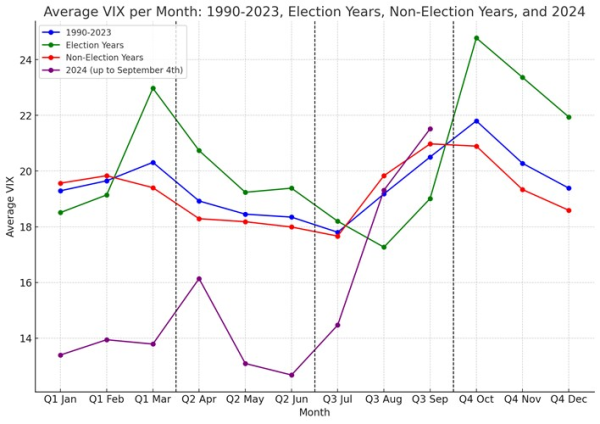Market on edge: navigating market turmoil and rising volatility
Diversification in action: navigating market turmoil and rising volatility
September 3, 2024, served as a stark reminder of the volatility we’re facing in the markets. While Wall Street remained closed for Labor Day on Monday, futures pointed toward a volatile trading session on Tuesday, reflecting the uncertainty ahead. Contributing to this unease was the ISM Manufacturing PMI, which came in less favorable than expected, signaling weaker growth in the manufacturing sector. Later in the day, further market jitters were sparked by reports that Nvidia had received a US Justice Department subpoena. However, it now appears that this news may be unfounded, adding confusion to an already volatile trading environment.
Amidst this market upheaval, volatility is climbing, as seen in the VIX seasonality chart, which shows a historical rise in the second half of the year. What’s particularly noteworthy in 2024 is how volatility has risen above historical averages beginning September, after a relatively calm first half.
As volatility rises, so does the risk to your portfolio. While you can’t control market volatility, you can manage the volatility of your portfolio. This is where diversification comes into play.

Volatility seasonality: what history tells us
The VIX seasonality chart provides a clear pattern: market volatility (measured by the VIX index) tends to spike in the second half of the year, particularly around August, September and October, as geopolitical risks and market-moving events accumulate. This year has followed that trend thus far. However, 2024 brings an additional factor: it’s a U.S. election year, a time typically associated with even greater volatility. As seen in the chart, volatility in election years tends to be higher, especially as the political uncertainty intensifies, adding another layer of risk to an already unstable market environment.
As this trend continues, maintaining a well-diversified portfolio becomes critical. Diversification helps spread risk across asset classes that behave differently, reducing overall exposure to market swings.
Preliminary research: diversified portfolios show signs of outperforming in volatile markets
Recent preliminary internal research on a subset of our clients suggests that diversified portfolios tend to perform better, particularly in uncertain and volatile markets. While the research is still ongoing, the early data from 2024 YTD already points to promising results. Clients with mixed portfolios (combining “domestic” and “foreign” assets) appear to outperform those with more concentrated holdings.
Key insights include:
- Clients with mixed portfolios have so far exhibited a 79% profitability rate, compared to 74% for domestic-only portfolios and 56% for foreign-only.
- These diversified portfolios also seem to experience less volatility, leading to higher profit per client and a greater share of profitable instruments.
While this research is not yet complete, it strongly supports the thesis that diversification reduces portfolio volatility and enhances returns during market turmoil. We expect further analysis to deepen these insights.
How to act in difficult market conditions
In challenging market situations, such as crashes and severe market corrections, it’s crucial to follow a thoughtful and strategic approach to protect your investments and potentially take advantage of opportunities. Here are some key steps:
- Stay calm and avoid panic selling: Emotional reactions can lead to hasty decisions. Avoid panic selling, as markets often recover over time.
- Rebalance and adjust your portfolio: Check if your portfolio still aligns with your long-term goals and risk tolerance. Rebalancing means adjusting your investments to maintain your desired mix. For instance, if stocks have performed well and now make up a larger portion than intended, consider selling some and reinvesting in other assets to restore balance.
- Focus on quality investments: Stick with reputable companies that have strong fundamentals. These companies are better positioned to withstand market downturns.
- Diversify your investments: Spread your risks by investing in various types of assets such as stocks, bonds, ETFs, and across different sectors and geographies. A well-diversified portfolio is more stable during market volatility.
- Maintain a long-term perspective: Focus on your long-term financial goals, looking five, ten, or twenty years ahead. Short-term fluctuations are less critical when you have a long-term investment horizon, as markets tend to recover over time.
- Keep cash reserves: Holding some cash provides flexibility and allows you to take advantage of buying opportunities during market declines. Cash reserves also ensure you won’t need to sell investments in case of a sudden expense or emergency.
- Consider dollar-cost averaging: By investing a fixed amount regularly, such as monthly or quarterly, you can buy assets at different prices, potentially lowering the average purchase price and mitigating the effects of market volatility.
- Review your stop-loss orders: If you use stop-loss orders to limit potential losses, check and adjust them based on current market conditions.
- Stay informed: Keep up with news and economic indicators, but avoid overreacting to short-term events that might not reflect the long-term outlook.
- Reassess your risk tolerance: High market volatility can test your risk tolerance. If market swings are causing you to lose sleep, it might be a sign that your risk exposure is too high. Adjust your strategy to align with your comfort level.
- Focus on strong financial health: Ensure your personal finances are in good shape. Only invest capital you don’t need immediately, so you're not forced to sell during downturns.
Conclusion: diversification is your best defense
Volatility is likely to persist for the rest of 2024, especially with the U.S. election adding to the uncertainty. However, by staying diversified and making strategic adjustments, you can protect your portfolio while positioning yourself to seize opportunities in volatile markets. At Saxo, we offer the tools and platforms to help you build a diversified, resilient portfolio that can thrive in any market condition.
| Previous "Market on edge" updates |
|---|
|